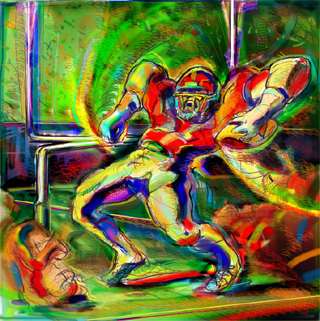
Spectator sports defy logic. The end. That otherwise rational people would get worked up into a rabid frenzy based on the outcome of a contest waged by two groups of millionaires who would rather have nothing to do with their fans is crazy enough, but that lunacy pales in comparison to the testosterone-fueled celebratory end zone jig.
Remember the 1986 Chicago Bears "Shufflin' Crew" and their benighted "Super Bowl Shuffle?" It was evidence, if anyone needed it, that the big men of the NFL are not natural dancers, or in most cases, dancers at all. But what happens after the big win, when the "V" for victory sign just isn't enough? Honey, it's time to get down and boogie.
Celebration hijinx run the gamut, from the universal fist pump to dog-piling, helmet-slapping, chest-bumping, ass-whacking, tongue-kissing... did I say tongue-kissing? I meant body-slamming... all the way to the more premeditated expressions of exultation, like the Mile High Salute, the stadium-as-moshpit vault into the crowd -- and, of course, end zone dancing.
The end zone dance (a contemporary, often ornithological form) includes the Icky Shuffle; Billy "White Shoes" Johnson's knee-flap boogie; Jamal Anderson's Dirty Bird (an elbow flappin', foot-scratchin' number that exhibits in moxy what it lacks in pathos) and peacock and chicken impersonations of every stripe. "Literally, rooster-strutting," observes Dr. Steven Berkowitz, a Los Angeles clinical psychologist.
And the crowd loves it. They watch for that vicarious triumph when the athlete, the symbol of the better self, engages an enemy, kicks ass on their behalf, and hopefully taunts the buggers as well. But there is a lot more to these on-field antics than their psychotherapeutic value for fans.
Celebrations are crucial to the mental game. Dr. Robert Smith calls it "non-verbal trash talk." It's saying, "To hell with you, I'm going to take a little break right now, I'm going to do a little boogie and I'm going to shake my butt in your face -- now what does your mama think of that?"
At the collegiate level, however, Mama doesn't like it much, since dancing the dance of victory is grounds for a fat penalty. On September 4, Michigan beat Notre Dame after wide receiver Bobby Brown was penalized 15 yards for a "Delayed Excessive Act" -- Brown twinkled his fingers beside his helmet at the Wolverine crowd, a subtle "nya nya" he obliquely described later as "doing something personal." Brown's foul was one of six celebration penalties called in eight Big Ten games that Saturday, calls which are "on the rise," says David Parry, Supervisor of Officials for the Big Ten Conference.
Officially, the rules were developed in response to a plea from the American Football Coaches Association in 1995 (expanding similar measures dating from 1993, 1991, and 1983) to stop the growing number of fights between players, some of which involved coaches. Provocative, delayed actions that distract attention from the team or the game in the quest for a "little camera time" are the problem, says Parry, but "you may celebrate with your own teammates." So, there's nothing wrong with a high five or a group hug.
Unofficially, there is a sense that the rules are racially biased, if not in intent, then in outcome. Vernon Andrews, in the Journal of African Men, argues that NCAA rules on sportsmanship descend from archaic British norms of civility, and in maintaining them, the NCAA maintains the white status quo. So the taunting and extroverted behaviors that are more commonly exhibited by black athletes are penalized in favor of a culture that thinks sticking out one's pinkie finger when drinking tea is the height of sophistication.
The rituals also highlight gender differences -- the recent media brouhaha about Brandi Chastain's sports bra flashing during the Women's World Cup, which culminated in a takeoff by Regis Philbin (dear God, poke out my eyes), is an example of not just the ways that men's and women's sports differ, but the ways they are becoming alike. Until now, women's celebrations have seemed to be less about self-promotion than congratulation, but both Smith and Berkowitz agree that the conflict between sororal feeling and corporate sponsorship means this is probably just a matter of time.
As sensationally entertaining as these rituals can be, there are many examples born less of true elation than the misguided desire to ploddingly enact the metaphorical significance of the immediately preceding play, such as the crowd salute or rolling the invisible die. "Is it creative?" asks Berkowitz. "Maybe the first time we saw it." But perhaps that's okay, since the athletes are there to win the game and the money first, inflict GBH second, and then, and only then, shake their booty like it's 1999.
See also: The Psychology of Celebration
Christine Kenneally is an Australian in Iowa.
